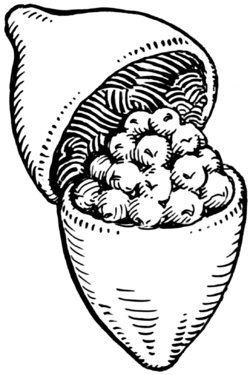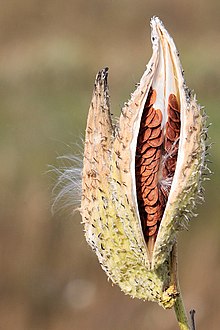Capsule (fruit)

Inbotany,acapsuleis a type of simple, dry, though rarely fleshydehiscentfruitproduced by many species of angiosperms (flowering plants).[1][2]
Origins and structure
[edit]The capsule (Latin:capsula,small box) is derived from a compound (multicarpellary)ovary.[2]A capsule is a structure composed of two or morecarpels.In (flowering plants), the termlocule(or cell) is used to refer to a chamber within thefruit.Depending on the number of locules in the ovary, fruit can be classified asuni-locular(unilocular),bi-locular,tri-locularormulti-locular.The number of locules present in agynoeciummay be equal to or less than the number of carpels. The locules contain theovulesorseedsand are separated bysepta.
Dehiscence
[edit]In most cases the capsule isdehiscent,i.e. at maturity, it splits apart (dehisces) to release theseedswithin. A few capsules areindehiscent,for example those ofAdansonia digitata,Alphitonia,andMerciera.Capsules are often classified into four types, depending on the type and location of dehiscence (see Simpson Fig 9.41[2]and Hickey & King[3]).

Loculicidal capsulespossess longitudinal lines of dehiscence radially aligned with thelocules,i.e.not at the septa, along the midrib or dorsal suture (seam) of the locules. If septa are absent, the dehiscence lines lie between theplacentae.This type is common among many members of theLiliaceaesuch asLilium(see illustration).
Septicidal capsuleshave dehiscence lines aligned with the sutures of the ovary septa or placentae, that is between the carpels.
Both loculicidal and septicidal capsules split into distinguishable segments calledvalves.The valves are a part of thepericarp(fruit wall) that has split away, without enclosing the seed or seeds. The borders of the valves may or may not coincide with the borders of carpels. These valves may remain attached to the fruit or fall off. In septicidal capsules the valves remain in place. In some capsules, the split occurs between carpels, and in others each carpel splits open.
Circumscissile capsules(pyxide,pyxis,pyxidiumorlid capsule) have a transverse, rather than longitudinal, dehiscence line, so that the upper part of the capsule dehisces, usually forming a terminal lid (operculum) that opens (see illustration). An example isPlantago.A variant is theSeptifragal capsule(valvular capsule) in which the outer walls break away from the septa and (usually axile) placentae as valves.
Poricidal capsulesdehisce through pores (openings) in the capsule, as inPapaver,the seeds escaping through these pores.

Examples of other plants that produce capsules includenigella,orchid,willow,cotton,andjimson weed.[2][4]
Specialised capsules
[edit]
Some dry dehiscent fruits form specialised capsule-like structures. Afollicleis derived from a single carpel that splits along a suture, as inMagnolia,while alegumesplits along two sutures, and are a defining feature of theFabaceae.Some variants of legumes that have retained vestigial sutures include loments that split transversely into segments, each with a single seed, and indehiscent legumes, such asArachis hypogaea(peanuts). Capsules derived from two carpels includesiliclesand siliques that dehisce along two suture lines but retain a partition called the replum, which is a septum with attached seeds. While both are characteristic ofBrassicaceae,silicles have a ratio of length to width of no more than 3:1.[5]Aschizocarpis derived from a compound ovary with two or more locules which then separate radially as one of the above types, such as a schizocarp of follicles, as inAsclepias(Asclepiadoideae) (see illustration).
Americarpis a portion of the fruit that separates from the ovary to form a distinct locule unit which encloses the seed, usually-nut-like, as inApiaceaein which the mericarps are joined by a stalk (carpophore). Thus a schizocarp of mericarps is a structure in which the carpels of a single ovary split to form mericarps. A schizocarp of nutlets is derived from a carpel that becomes lobed, and the lobes become nutlets that split apart. Examples includeBoraginaceaeand mostLamiaceae,where the styles are attached between the ovary lobes.[2][4]
Nuts
[edit]Capsules are sometimes mislabeled asnuts,as in the example of theBrazil nutor theHorse-chestnut.A capsule is not a nut because it releases its seeds and it splits apart. Nuts, on the other hand, do not release seeds as they are a compoundovarycontaining both a single seed and the fruit. Nuts also do not split. In the Brazil nut, a lid on the capsule opens, but is too small to release the dozen or so seeds (the actual "Brazil nut" of commerce) within. These germinate inside the capsule after it falls to the ground.
See also
[edit]References
[edit]- ^Chisholm, Hugh,ed. (1911)..Encyclopædia Britannica(11th ed.). Cambridge University Press.
- ^abcdeSimpson 2011,Simple fruit types pp.384–386
- ^Hickey & King 2000,Capsule dehiscence p. 136
- ^abDahlgren, Clifford & Yeo 1985,Fruit p. 15.
- ^Schmid, Rudolf; Graham, Linda E.; Graham, James M.; Wilcox, Lee W. (Warren); Stern, Kingsley R. (Rowland); Bidlack, James E.; Jansky, Shelley H.; Uno, Gordon E. (1 May 2005)."Plant Biology".Taxon.54(2): 573.doi:10.2307/25065406.ISSN0040-0262.JSTOR25065406.
Bibliography
[edit]- Simpson, Michael G. (2011).Plant Systematics.Academic Press.ISBN978-0-08-051404-8.
- Dahlgren, R.M.;Clifford, H.T.; Yeo, P.F. (1985).The families of the monocotyledons.Berlin: Springer-Verlag.ISBN978-3-642-64903-5.Retrieved10 February2014.
- Hickey, Michael; King, Clive (2000).The Cambridge illustrated glossary of botanical terms.Cambridge:Cambridge UniversityPress.ISBN978-0-521-79401-5.
- Encyclopædia Britannica online
- The seed site
